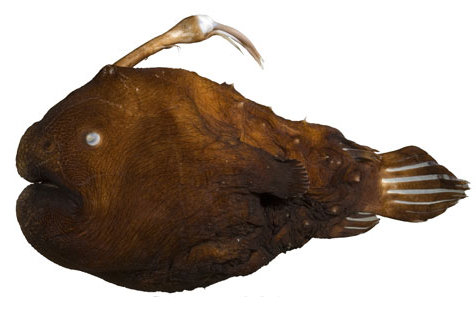Footballfish, Himantolophus albinares Maul 1961

Himantolophus albinares. Source: Museum of Comparative Zoology, Harvard University. License: CC by Attribution-NonCommercial-ShareAlike
Summary:
A brownish-black footballfish with black fins, two parallel stripes along the back, wide anteriorly at the illicial base to thin posteriorly at dorsal fin insertion, and distinct patches on base of illicium, on dorsal and ventral side of caudal peduncle, on insertion of dorsal and anal fin s and on first dorsal fin ray. All the white blotches on the body and a white spot on the dorsal and ventral margins of the caudal-fin base. The illicium is short, positioned above the eyes, and the esca (lure) has two pairs of swellings in the distal end, the anterior pair only half as long as the posterior pair.
Himatolophids, like all ceratioid anglerfishes, are extremely sexually dimorphic, with the dwarf males only reaching a fraction of the size of females.
Himatolophids, like all ceratioid anglerfishes, are extremely sexually dimorphic, with the dwarf males only reaching a fraction of the size of females.
Cite this page as:
Bray, D.J. 2020, Himantolophus albinares in Fishes of Australia, accessed 16 Apr 2024, https://fishesofaustralia.net.au/home/species/4800
Footballfish, Himantolophus albinares Maul 1961
More Info
|
Distribution |
South of King Island, Bass Strait, to south of Tasmania. Elsewhere the species occurs in the Atlantic and Western Pacific Oceans. |
|
Features |
Dorsal fin 5; Anal fin 4. Illicium short, its base above eyes;; two pairs of swellings in the distal end of esca, the anterior pair only half as long as the posterior one. Distinguishing characteristics of metamorphosed female: length of illicium 36-54% SL in specimens greater than 3 cm; deeply cleft distal escal appendage, undivided part 1.0-9.4% SL; each primary branch of distal escal appendage simple, darkly pigmented except on distal tip, total length 8-13% SL in specimens 3.4-6.6 cm, 25-74% SL in specimens 7.5-19 cm; length of posterior escal appendage 8.5-21% SL in specimens 3-19 cm, faint pigmentation or absent; illicial stem with posterolateral appendages 2-9, simple or branched at tip, longest 7-23% SL in specimens greater than 3 cm; absence of dermal spinules on escal bulb and appendages |
|
Size |
The largest known female specimen was 46.5 cm standard length, and males reach about 4 cm. |
|
Feeding |
Female football fish passively attract prey by using a luring device (illicium and esca), a modified first dorsal-fin spine. |
|
Biology |
The free-living males are very much smaller than females, and use their highly developed sensory organs to actively seek a female partner. Once they have found a mate, they attach themselves to the female but are not parasitic. |
|
Etymology |
The specific name albinares is from the Latin albus (= white) and nares (= nostril) in reference to the white “oval, papilla-like bulges on which the nostrils are placed”. |
|
Species Citation |
Himantolophus albinares Maul 1961, Boletim do Museu Municipal do Funchal 14(50): 111, figs. 11-15. Type locality: off Câmara de Lobos, Madeira. |
|
Author |
Bray, D.J. 2020 |
|
Resources |
Footballfish, Himantolophus albinares Maul 1961
References
Bertelsen, E. 1986. Himantolophidae. pp. 1378-1380 in Whitehead, P.J.P., Bauchot, M.-L., Hureau, J.-C. & Tortonese, E. (eds) 1986. Fishes of the North-eastern Atlantic and the Mediterranean. Paris : UNESCO Vol. 3 pp. 1015-1473.
Anderson, M.E. & Leslie, R.W. 2001. Review of the deep-sea anglerfishes (Lophiiformes: Ceratioidei) of southern Africa. Ichthyological Bulletin of the J.L.B. Smith Institute 70: 1-32. See ref online
Knudsen, S. 2015. Himantolophus albinares. The IUCN Red List of Threatened Species 2015: e.T60470792A60790660. https://dx.doi.org/10.2305/IUCN.UK.2015-4.RLTS.T60470792A60790660.en. Downloaded on 09 December 2020.
Maul, G.E. 1961. The ceratioid fishes in the collection of the Museu Municipal do Funchal (Melanocetidae, Himantolophidae, Oneirodidae, Linophrynidae). Boletim do Museu Municipal do Funchal 14(50): 87-159
Pietsch, T.W. 2009. Oceanic Anglerfishes. Extraordinary Diversity in the Deep Sea. Berkeley and Los Angeles : University of California Press pp. i-xii + 1-557.
Stewart, A.L. & Pietsch, T.W. 2010. A new species of deep-sea anglerfish, genus Himantolophus (Lophiiformes: Himantolophidae) from the western South Pacific, with comments on the validity of H. pseudalbinares. Zootaxa 2671: 53-60. http://doi.org/ 10.5281/zenodo.199134
Stewart, A.L., Pietsch, T.W. & Kenaley, C.P. 2015. 118 Family Himantolophidae. pp. 908-915 in Roberts, C.D., Stewart, A.L. & Struthers, C.D. The Fishes of New Zealand. Wellington : Te Papa Press Vol. 3 pp. 577-1152.



